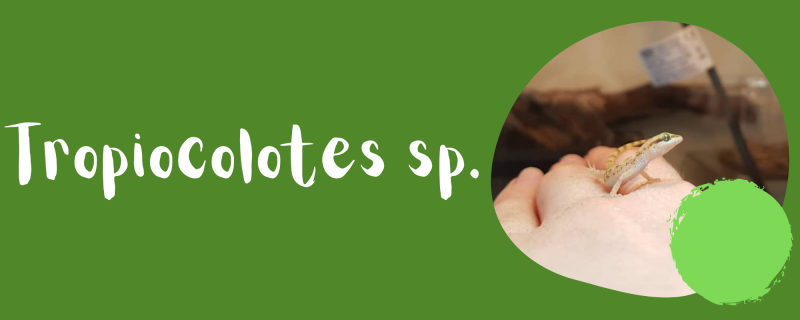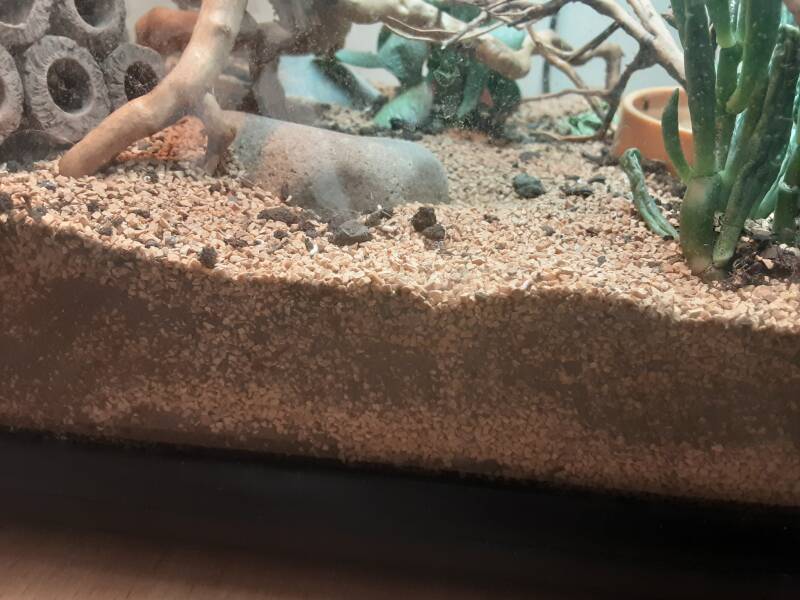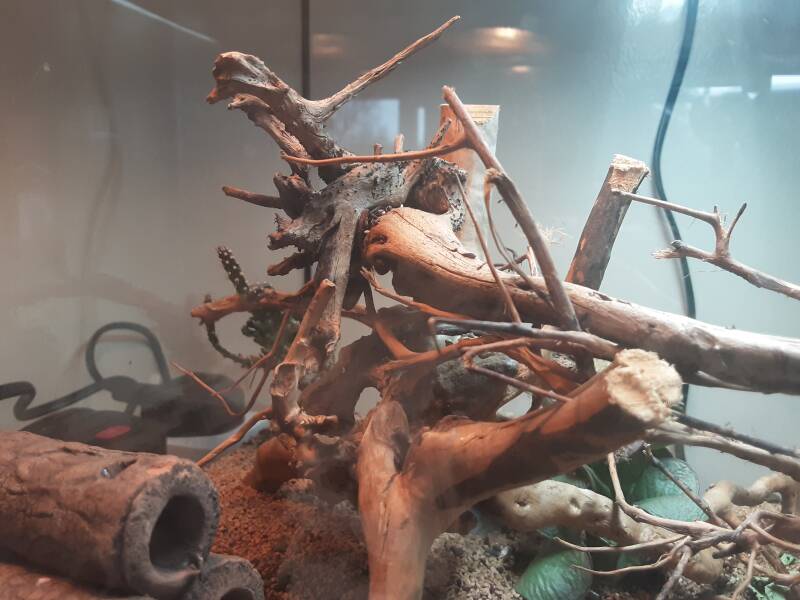
Please note, the Tropiocolotes genus is broad and features many of the arid dwarf gecko species found across norther Africa and the Middle East. The care requirements of each of these are largely the same, so for educational purposes this care sheet is written to cover most of this genus. We keep Tropiocolotes steudneri, so this care sheet is based off our experience with this species. To ensure you get the best information possible, I would advise the use of a species-specific care sheet alongside this.
In the wild-
Our species is native to the northwest of Africa, where it tends to inhabit sand dunes and rocky arid areas, hiding between rock crevices to escape the harsh heat. Listed as ‘Least Concern’ they have no pressing threats and are believed to be doing well. This being said, an overall lack of species knowledge suggests that we may not be aware of the full story. They are small and active geckos and tend to come out as the lights turn off for the evening, a wild adaptation to deal with heat and reduce predation.
What do they look like?
The colouring and patterning of these reptiles seems to vary quite heavily between individuals, with bodies often showing mottled patterns of grey, yellow and brown. They have a dark streak surrounding their eyes, a feature shared with many arid species, which helps to reduce the glare from the sun. A characteristic of the Tropiocolotes family is their small size, with most species reaching just 5cm (approximately 2 inches) in length. I have been unable to find information regarding lifespan, however at the time of writing our oldest geckos are predicted to be at least 5 years old.
Suitability-
Whilst their small size and hardy nature makes them ideal pets, they should be considered a display species. As they are so small, they are quite delicate and should not be handled unless necessary. I would not recommend this species to anyone looking for an interactive and handleable pet reptile.
Housing and the environment-
Whilst these geckos are tiny, usually growing no more than 5cm in length, they are incredibly active and will benefit from any space you offer them. I would recommend keeping a group of 4-6 individuals in nothing smaller than a 30x30x30cm tank (12-inch cube), however the bigger the better. Our colonies are each housed in converted 10-gallon aquariums, which make the ideal enclosure with minimal modification.


As with all reptiles, the correct heating and lighting is vital to every setup, as it helps to reduce the chances of Metabolic Bone Disease (MBD) in your animals. The condition can have horrific long-term consequences and cause deaths. This species thrives best in extremely hot environments, with a temperature gradient of 25 to 30 degrees Celsius (77 to 86f) and a basking spot of 40 degrees Celsius (104f). Nighttime temperatures should be maintained above 20 degrees (68f), yet this is unlikely to require additional heating considering average room temperatures. These high daytime temperatures are best created by a thermostatically controlled halogen bulb and should be monitored using a digital thermometer.
UVB lighting is also vital in preventing MBD due to its role in converting vitamin D (found in the diet) into vitamin D3 to allow calcium to enter the body. Often exposed to high UVB levels in the wild, a 10% UVB bulb will meet this species’ needs. This should be placed in such a way that it creates a slight gradient within the enclosure, whilst still covering the entire area.
Both light-emitting heating elements and lighting are usually controlled by a plug-in wall timer on a 12 hours on, 12 hours off cycle. Product advancement and better species understanding means that some keepers are beginning to implement seasonal cycles into their enclosures, which can be done by simply altering the timer.
The next consideration will be the setup itself. In all my setups I try to use as many natural materials as possible, many of which can be scavenged for cost-effective enclosures. For these geckos I use plenty of rock, dessert roots and cork bark. These materials can be used to form hides, enable digging, and provide basking spots. It is important in socially kept species to ensure that the basking area is large enough to accommodate all the individuals, so consider this when deciding the placement of enclosure features. Live succulent plants can also be added, as this species is small and unable to damage most plants- this means it is even possible to go a step further and create a bioactive enclosure.
I have used several different substrates with my geckos, many of which are sourced from either ProRep or Arcadia. Arcadia produce an arid soil substrate which is great to use in bioactive setups, whilst the ProRep range includes substrates suited to several different biomes. I have previously used their desert, Mediterranean and arid substrates with my African species.

Humidity-
As an arid species, humidity levels should be maintained to a low level. Around 20% will replicate their natural environment, and this requires very little effort to maintain. I tend to give a light misting each morning to simulate morning dew settling on plants and rocks, which also gives the geckos an additional chance for a drink.
Humidity can be monitored using a hydrometer or combometer, to help you maintain the correct parameters.
Diet and feeding-
Due to their tiny size, there is quite a limit on the foods available for these geckos, and finding the correct foods can be difficult. Three times weekly, our colonies are offered calcium and vitamin supplemented live feeds, usually either micro crickets or flightless fruit flies.
A small and shallow water bowl with easy access out should also be always available to the animals. Whilst arid reptiles tend to source most of their water through their diets, it is still important that this option is always there. Similarly, liquid supplements provided through the water are not likely to be effective for this reason.
Cleaning-
As with any captive animals, regular spot cleaning is required to keep the environment clean and the animals healthy. This can be quite difficult with these geckos due to the tiny size of their waste. I have found that many of them defecate on a rock, which allows me to brush it off easily for removal.
Monitoring your colonies is important when considering cleaning, as young animals and eggs could be easily missed during a full clean and accidentally discarded. Full cleans should be done as frequently as you believe necessary, and when keeping on top of spot cleaning this can be as little as every few months.
Breeding-
When the environment is right, these geckos will breed. The most successful way of encouraging successful breeding is through the heat. Our gecko tank was previously heated to the mid 30s, however the decision was made to swap to a more powerful bulb, creating a basking spot of closer to 40 degrees Celsius. Since this change, our geckos have produced several offspring.
Besides heating, ensuring that you supply a good substrate and plenty of hiding places in which to lay will also encourage breeding in your geckos. It is also important to keep supplementing diets, as females will be using vast amounts of calcium and energy to produce their- comparative to the size of their body- large eggs.
Sourcing your gecko-
Tropiocolotes tripolitanus are an incredibly underrated and difficult to obtain species and I can find no reason as to why. These geckos provide hours of entertainment as you watch them go about their day and they are an amazing, inspiring species. When I first came across the species in my local pet shop, I was in awe of their minute size, shocked that a reptile so small could exist. To me, they are the most beautiful, interesting and rewarding gecko species to keep that I know of. I would highly recommend this brilliant little lizard to any new or existing keeper.
When they are available for sale, they are likely to be sourced from one of two places, either imported from the wild, or bred by private keepers. For sustainability and to ensure your geckos are healthy, always try to obtain captive bred individuals.
At the Menagerie-
We have housed these incredible geckos for several years now, and the population has seen a drastic increase! We began with a group of 5 individuals, who were named the Jackson 5. In recent years, our husbandry methods have been adapted which has seen plenty of successful breeding, and in just a few short months we found ourselves with nearly 20. Future proofing is definitely an important consideration with this species! For updates on our geckos, and the rest of the menagerie, check out our Instagram @alis_menagerie.
You can find out more about the care and breeding of these tiny reptiles in the May 2024 issue of Exotics Keeper magazine, with my article: 'Micro Marvels: the care and breeding of Tropiocotes'.

Thank you for reading my Tripiocolotes care sheet and I hope you found it helpful and informative. Good luck with your new reptile!
This care sheet has been written through the combination of my own experiences (I will only write about species I have worked with) and the knowledge, experience, and recommendations of other keepers in the exotic-keeping community.